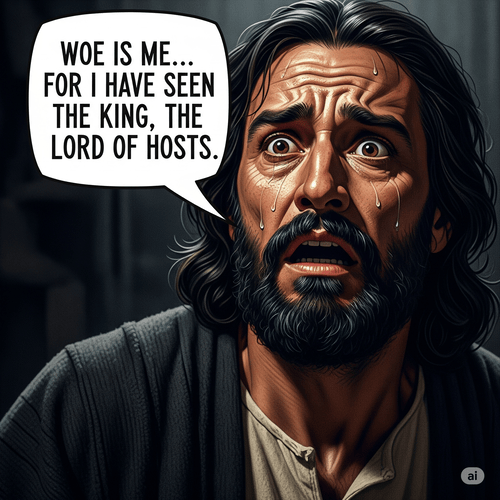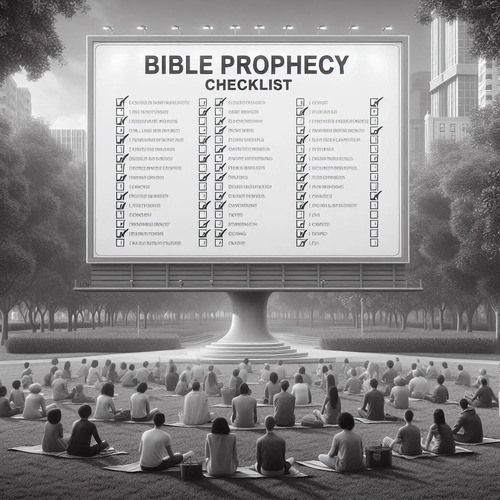Nails and Piercing in Prophecy: Why The Messianic Details Matter
Prophecy unveils the meticulous plan of God in redemptive history—every detail of Christ’s suffering was foreseen, down to the nails in His hands and the piercing of His side. These crucial elements of the cross are often overshadowed by broader discussions of the Messiah’s sacrifice. However, multiple prophets foretold them with striking precision. David, Isaiah and Zechariah—all testify to the piercing that would mark the Saviour’s suffering.
Clearly, the cross was no accident of history, nor the triumph of human will over Christ. Far from being a victim of circumstance, Jesus declared in John 10:18, “No one takes my life from me, but I lay it down of my own accord.” Even the nails and the piercing were part of His sovereign decision—His life wasn’t snatched from Him; He gave it, fulfilling prophecy down to its smallest details…
THE PROPHETIC TEXTS
Long before crucifixion was invented as an execution method, multiple Hebrew prophets wrote about piercing in connection with the coming Messiah:
- Psalm 22:16: “Dogs surround me, a pack of villains encircles me; they pierce my hands and my feet.” Written by David around 1000 BC, this psalm vividly describes crucifixion centuries before it existed as a Roman punishment.
- Isaiah 53:5: “But he was pierced for our transgressions, he was crushed for our iniquities; the punishment that brought us peace was on him, and by his wounds we are healed.” Isaiah wrote these words approximately 700 years before Christ.
- Zechariah 12:10: “And I will pour out on the house of David and the inhabitants of Jerusalem a spirit of grace and supplication. They will look on me, the one they have pierced, and they will mourn for him as one mourns for an only child.” Written around 520 BC, Zechariah’s prophecy speaks of the piercing of God Himself.
These prophecies are remarkable because they predict a method of execution that wasn’t invented until centuries later.
HISTORICAL CONTEXT AND FULFILLMENT
Crucifixion originated with the Persians and was later adopted and perfected by the Romans around the 3rd century BC—well after these prophecies were written. The specificity of these prophecies becomes even more striking when we consider their fulfillment in the Gospels:
In John 19:34-37, we read: “Instead, one of the soldiers pierced Jesus’ side with a spear, bringing a sudden flow of blood and water… These things happened so that the scripture would be fulfilled: ‘Not one of his bones will be broken,’ and, as another scripture says, ‘They will look on the one they have pierced.’”
After the resurrection, Thomas specifically needed to see “the nail marks in his hands” (John 20:25) to believe, providing additional confirmation of the fulfillment.
THE THEOLOGICAL SIGNIFICANCE
From a Reformed perspective, these precise fulfilments highlight several important theological truths:
- God’s Sovereignty: Not even the smallest details in Scripture are accidental. God sovereignly orchestrated every aspect of redemptive history, including the specific method of Christ’s execution.
- Particular Providence: The Lord didn’t just vaguely know Christ would die—He knew and ordained every detail, including the specific wounds Christ would bear.
- Biblical Inerrancy: The accuracy of these prophecies testifies to Scripture’s divine inspiration and reliability.
- Substitutionary Atonement: The piercing was more than just a method of execution—it symbolises the punishment Christ bore in our place. As Isaiah declares, “He was pierced for our transgressions.”
WHY THESE DETAILS MATTER TODAY
These seemingly small prophetic details carry profound implications for believers today:
- Faith Foundation: Specific fulfilled prophecies provide powerful evidence for the Bible’s divine inspiration. In moments of doubt, we can remember that God revealed even the mechanics of Christ’s death centuries before they occurred.
- Comfort in God’s Control: A God who planned the details of salvation so meticulously can certainly handle the details of our lives. Nothing escapes His notice or control.
- Encouraging Careful Study: These prophecies reward those who carefully study Scripture, reminding us every word is God-breathed and significant.
- Deepening Worship: Understanding the precision of prophecy deepens our worship. The God we worship reveals Himself through specific details that affirm His trustworthiness.
CONCLUSION: NAILS AND PIERCING IN PROPHECY
The prophecies about nails and piercing are far more than interesting Bible trivia. They represent the perfect harmony between God’s sovereign plan and Christ’s willing submission. When Jesus declared, “No one takes my life from me, but I lay it down of my own accord,” He was affirming His conscious choice to fulfil every prophecy—including those that spoke of His pierced hands and feet.
Our faith rests on the solid foundation of a Saviour who willingly embraced the nails for our sake. Christ wasn’t caught in the machinery of fate; He actively chose the path that led to those prophesied piercings. The hands that created the universe submitted willingly to the nails, fulfilling prophecies written centuries in advance—demonstrating both divine foreknowledge and love…
NAILS AND PIERCING IN PROPHECY: RELATED FAQs
How do Jewish interpretations of Psalm 22:16 differ from Christian readings? Traditional Jewish interpretations often translate Psalm 22:16 as “like a lion, they are at my hands and feet” rather than “they pierced my hands and feet.” This translation debate stems from the Hebrew word kaaru which ancient Christian translations rendered as “pierced” while some Jewish scholars argue for “like a lion.” The Dead Sea Scrolls discovery supports the “pierced” translation, providing ancient manuscript evidence predating the Christian-Jewish interpretive divide.
- Couldn’t the Gospel writers have fabricated details to match prophecies? The crucifixion accounts appear in all four Gospels and correspond with Roman historical practices, making fabrication unlikely. Multiple independent sources confirm these details, including non-Christian writers like Josephus and Tacitus. Furthermore, the disciples who recorded these events showed willingness to die for their testimony, suggesting they genuinely believed what they wrote.
- Were nails always used in crucifixion, or is this historically significant? Roman crucifixion methods varied widely, with some victims tied to crosses rather than nailed. Archaeological evidence, particularly the 1968 discovery of crucified remains with a nail still embedded in the heel bone, confirms that nails were sometimes used but weren’t universal. This makes the prophetic specificity about piercing even more remarkable, as it wasn’t just predicting crucifixion but a specific method of crucifixion.
How do we know Psalm 22 was written before Jesus’ time? The Psalm 22 manuscript found among the Dead Sea Scrolls dates to approximately 100-50 BC, definitively establishing its existence before Christ’s crucifixion. The Septuagint (Greek translation of Hebrew Scriptures) was completed around 132 BC and also contains this psalm. Historical and linguistic analysis further confirms Davidic authorship around 1000 BC, placing it almost a millennium before crucifixion was invented.
- Are there other ancient religions with similar prophecies about piercing? While several ancient religious texts contain death and resurrection themes, none feature the specific prophetic elements of hand and foot piercing that perfectly align with a future execution method. Ancient Mesopotamian and Egyptian religious texts contain various suffering deity motifs but lack the precise predictive elements found in the Hebrew prophecies. This specificity sets biblical prophecy apart from general mythological patterns found in other ancient religious texts.
- What about Zechariah 12:10’s context? Isn’t it about something else entirely? Zechariah 12 discusses Jerusalem’s future deliverance, which has led some interpreters to disconnect it from Messianic prophecy. However, the text specifically mentions “looking upon the one they have pierced” and connects this to “mourning for an only son,” creating unmistakable Messianic overtones. The Reformed understanding recognises that prophecies often have both immediate contexts and future fulfilments—a pattern throughout Scripture where God’s redemptive purposes unfold across multiple historical horizons.
How can we be certain the Hebrew word for “pierce” in these prophecies matches crucifixion wounds? The Hebrew words kaaru (Psalm 22:16) and daqar (Zechariah 12:10) specifically denote piercing or boring through, not merely wounding in general. Daqar in particular is used elsewhere in Scripture to describe being run through with a spear or sword, perfectly matching the piercing of Jesus’ side. The precision of these terms, combined with their fulfillment in crucifixion—a punishment not invented until centuries after these prophecies—provides compelling evidence of divine foreknowledge.
NAILS AND PIERCING IN PROPHECY: OUR RELATED POSTS
Editor’s Pick

Was Jesus Abandoned by the Father on the Cross?
WHY WE ANSWER IN THE NEGATIVE “My God, my God, why have you forsaken me?” These words from the cross [...]

Why Do Some Respond to God’s Call While Others Don’t?
THE REFORMED VIEW ON OUTWARD AND INWARD CALLS EXPLAINED Picture this: Two neighbours attend the same church service. They hear [...]

Does Ocean Salt Content Prove a Young Earth?
A COMPELLING LOOK AT MARINE CHEMISTRY AND EARTH’S TIMELINE The Salt Question That Challenges Deep Time: If Earth’s oceans have [...]
Noah’s Flood: Where Did All the Water Come From? And Go?
The question hits every Bible-believing Christian at some point: “If Noah’s flood covered the whole earth, where did all that [...]

No Marriage in Heaven? What Does Mark 12:25 Mean?
“Will I see my spouse in heaven? Will we still be married?” These questions pierce the heart of every Christian [...]

The Terror of Meeting God: What Isaiah 6 Reveals About Divine Holiness
WHEN ‘WOE IS ME’ IS THE ONLY PROPER RESPONSE TO A GLIMPSE OF GOD Picture this: You’re a prophet of [...]

Is the Holy Spirit Present in Unbelievers? The Biblical Answer
Can someone who doesn’t believe in Jesus Christ have the Holy Spirit living inside them? This question strikes at the [...]

The Gap Theory Exposed: Why Embrace a Young Earth?
The Gap Theory proposes there’s a vast time gap—millions or billions of years—between Genesis 1:1 (“In the beginning God created [...]

Rethinking Sickle Cell Anaemia: A Case for Intelligent Design
Sickle cell anaemia presents what many consider evolution’s strongest card—a genetic condition that causes suffering yet provides protection against malaria. [...]

‘Bad’ Design: Flaw in Nature Or Flaw in Our Perspective?
When the Eiffel Tower was first proposed, critics called it a monstrous eyesore that would ruin Paris forever. Today, it’s [...]






